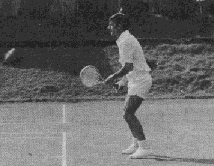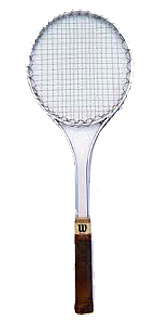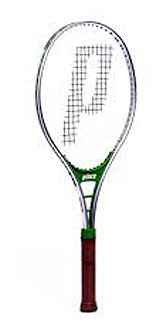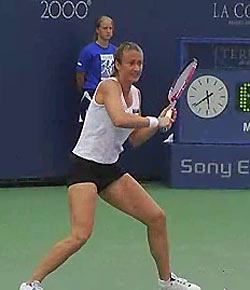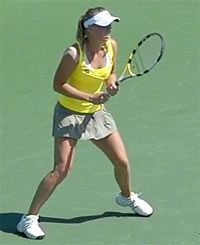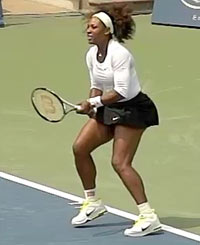|
TennisOne Lessons Great Tennis Milestones in the Open Era Paul Fein At its historic special meeting in Paris, March 30, 1968, the International Lawn Tennis Federation dealt the death blow to "shamateurism”—the corrupt system allowing marquee amateurs to pocket under-the-table payments far exceeding the rules. The ITF’s 66 representatives from 47 nations voted unanimously to approve 12 open tournaments in eight countries for 1968. No longer would a tour player quip "I’m an amateur by profession,” as Gordon Forbes did when asked what he did for a living. For the first time in history, all the world’s best players who chose to do so competed at an Open tournament, the British Open Hard-Court Championships in Bournemouth, England, on April 22. Amateur Mark Cox initially stole the show by upsetting aging pro Pancho Gonzalez and first-year pro Roy Emerson, before Rod Laver routed Cox in the semis. Another old pro, Ken Rosewall, then beat Laver to collect the first "open” paycheck, a modest $2,400. Virginia Wade won the women’s title but declined the $720 first prize, worried about giving up her amateur status at this uncertain time.
Just about everybody else was ecstatic, though, especially the pioneering organizers of the tournament. "We knew Open Tennis was going to be a success, but we didn’t know it was going to be a bonanza!” enthused the Lawn Tennis Association’s Derek Hardwick. The Brave New World of Open Tennis would bring record crowds and strange categories such as "registered players” and "contract professionals” which were soon abolished. There would also be a surge of corporate sponsors, tournament entrepreneurs and opportunistic player agents, undreamed-of prize money, lucrative endorsement contracts, and burgeoning television coverage. Rival political factions battled intensely for control of the game. Year-round men’s and women’s pro circuits were born, and tennis enjoyed dramatic worldwide growth. On the debit side, the Davis Cup declined in prestige, as did doubles and mixed doubles events. Defective pro ranking systems failed to count all bona-fide tournament matches, allegations of tanking surfaced too often, and appearance money (viz., guarantees)—both legal and illegal— continued to sully the game. But no one who lived through both the amateur and Open eras would choose the former, even while waxing nostalgic over bygone wood rackets and sporting gentlemen. In most ways, tennis today is better, bigger, and more entertaining than ever. Prize money is offered for the first time at the Grand Slam events at the 1968 French Open. Australian Ken "Muscles” Rosewall won Roland Garros (15 years after his first title there) and collected 15,000 francs. In a sign of those times of gender inequality, American Nancy Richey received one-third of that, 5,000 francs, for capturing the women’s crown. Open Tennis effectively ended the hypocrisy of "shamateurism” and started a new era where prize money would grow to a staggering $3 million for the 2014 US Open men’s and women’s singles champions. Women’s professional tennis is launched in 1970 when nine players (Peaches Bartkowicz, Rosie Casals, Judy Dalton, Kristy Pigeon, Nancy Richey, Valerie Ziegenfuss, Julie Heldman, Kerry Melville and Billie Jean King) signed $1 contracts with World Tennis magazine publisher Gladys Heldman to compete on a new women’s tour. The inaugural Virginia Slims of Houston was established on September 23, 1970. A year later, the Virginia Slims Circuit debuted with 19 tournaments offering a total purse of $309,100 in the United States. In 2014, the WTA Tour played 58 events (including 4 Grand Slam events) in 34 countries, plus the Fed Cup, with players competing for a record-setting $118 million in prize money. The tiebreaker shortens and enlivens matches. Jimmy Van Alen, a New England aristocrat with revolutionary ideas, created the game’s first major scoring innovation, thus replacing boring and exhausting marathon sets and matches with thrilling climaxes. The nine-point "sudden-death” tiebreaker made its Grand Slam debut at the 1970 US Open, and tennis was never to be the same again. At 6-6 in games and four points all, both players faced simultaneous set and/or match point, which a skeptical John Newcombe called "terribly nerve-wracking.” Disgruntled players agreed, and in 1972 Wimbledon adopted the 12-point tiebreaker in every set except the last at 8-games-all, waiting until 1979 to reduce it to 6-games-all. The most famous and exciting tiebreaker in history was won 18-16 by John McEnroe in the fourth set of his epic five-set loss to Bjorn Borg in the 1980 Wimbledon final. Teen phenoms fascinate the sporting public. Teenage prodigies go all the way back to England’s Charlotte "Lottie” Dod who still holds the record as the youngest player (at 15 years, 285 days) to win Wimbledon in 1887. But teen phenoms proliferated as never before in the Open Era starting with Chrissie Evert who upset No. 1 Margaret Court at 15 and reached the 1971 US Open semis at 16. The 1970s also featured teen queens Evonne Goolagong and Tracy Austin. The 1980s introduced Steffi Graf, Monica Seles, and Arantxa Sanchez Vicario. And the 1990s saw Serena Williams, Olympic gold medalist Jennifer Capriati, and precocious Martina Hingis who won all her five major singles titles before turning 19. At the 1997 Aussie Open, the smiling Swiss became the youngest Grand Slam titlist since Dod and the youngest No. 1 that year, both accomplished at 16. This century, Maria Sharapova upset Serena to win the 2004 Wimbledon at 17. Mats Wilander, Boris Becker, and Michael Chang astounded everyone by seizing majors at 17, while this century Rafael Nadal became the only male teenage Slam champ at the 2005 French Open.
Arthur Ashe becomes the first African-American man to win a Grand Slam title at the inaugural US Open in 1968. Althea Gibson broke the color barrier in tennis by competing at the 1950 U.S. Championships and then winning the 1956 French title and 1957−58 Wimbledon and U.S. titles. In a New York Times column, Ashe wrote: "For 120 years, white America has gone to extraordinary lengths to discredit and discourage black participation in sports because black athletes have been so successful.” The only other black man to capture a major singles title (the 1983 French Open) was Frenchman Yannick Noah, whom Ashe discovered as a talented 11-year-old in Yaounde, Cameroon. An ATP-ILTF dispute causes a Wimbledon boycott. The Association of Tennis Professionals, a players’ union formed in 1972, faced its first tough political battle in 1973. The International Lawn Tennis Federation (now the ITF) suspended Nikki Pilic for nine months for refusing to play Davis Cup for Yugoslavia. Both the Italian Open and French Open caved when the ATP threatened to boycott their tournaments if they didn’t let Pilic compete. But Wimbledon called their bluff. Even though 84 of the 87 ATP players booked to play Wimbledon didn’t compete, the decimated men’s field didn’t prevent The Championships from attracting its second-biggest attendance. Even so, as Aussie star John Newcombe wrote in his autobiography, "The powers-that-be knew we were a powerful body that was not about to be pushed around any longer. By trying to break us, the ILTF only made us stronger. Nikki Pilic was reinstated three weeks later.”
The racket revolution changes tennis forever. The first shots were fired at the 1967 U.S. Championships. Billie Jean King won it, but the big surprises came when Clark Graebner reached the final, and part-time player Gene Scott made the semis. All wielded the new Wilson T2000, a strange-looking steel racket. The weapon gained its greatest notoriety when Jimmy Connors used it to win three-fourths of a Grand Slam in 1974. The trend away from wood accelerated when Pam Shriver, a 16-year-old darkhorse, reached the 1978 US Open final with a 110-sq.-inch, aluminum Prince frame. Today, a wide array of high-tech rackets made with space-age materials and strung with spin-enhancing polyester are much bigger (heads typically range from 95- to 115-sq. inches in contrast to 65-68 sq. inches for wood rackets), lighter, more shock-absorbent, and powerful than ever. The last time a Wimbledon player used a wood racket was in 1987. Western forehands and two-handed backhands profoundly change the way tennis is played. Although Bjorn Borg didn’t invent the Western forehand—Californians Maurice McLoughlin and Bill Johnston won major titles more than 60 years earlier with it—he proved the Western grip and stroke could win regularly on grass. He captured five straight Wimbledon titles from 1976 to 1980. Borg, Connors, and Chris Evert popularized the two-handed backhand in the 1970s, and coaches everywhere started teaching it to youngsters eager to emulate these charismatic champions. Both playing styles produced more power, topspin, and consistency. Now, 76 percent of the top 100 men and 97 percent of the top 100 women employ a two-handed backhand, and the vast majority use either a Western or semi-Western forehand. A televised match between Australian legends helps ignite America’s 1970s tennis boom. A record tennis audience of 23 million watched spellbound as Ken Rosewall outlasted Rod Laver 4-6, 6-0, 6-3, 6-7, 7-6 in the 1972 WTC Finals final in a masterpiece of breathtaking shot-making. The marathon match spilled into "prime time” and helped turn Americans on to tennis. Equally important, it convinced television moguls that the one-time sport of the wealthy few was now perfect for the viewing masses. "Television is an incredible vehicle,” explained World Championship Tennis executive director Mike Davies. "Nothing in the history of communications can compare with it. It is quite possible for a player to play one match on national television before more people than he would ever play live to in his whole career.”
Men and women receive equal prize money for the first time. In 1973, the US Open did the right thing and became the first of the four Grand Slam tournaments to offer equal prize money to men and women. Regrettably, the other three majors fought against it tooth and nail using dubious rationales for many more years. Not until 2001 did the Australian Open fully commit to equal prize money. And Wimbledon and the French Open finally provided it in 2007. The "Capriati rule” is enacted. In 1995, to prevent mental and physical burnout among young players—most notably, Tracy Austin and Andrea Jaeger, who retired prematurely at age 20 and 21, respectively, and Jennifer Capriati—the WTA Tour introduced age-eligibility rules. They barred 13-year-olds from WTA tournaments and allowed precocious players, 14, 15, 16, and 17, to play gradually more often and in more important events as they got older. As a result, the number of world-class teenage players steadily decreased, while the average age of the top 10-ranked women increased from 22.4 years old in 2004 to 25.8 years old in 2014. The US Open and Australian Open change surfaces to hard courts. The U.S. Championships, which had been played on grass from 1881 to 1974 before a three-year flirtation with a clay-like Har-Tru surface, switched to Deco-Turf II hard courts in 1975. The controversial move drew protests from some players who contended the fast surface favored American players, which it did. The Australian Open, played on grass from 1905 to 1987, switched to green Rebound Ace courts in 1988 and then installed more forgiving True Blue Plexicushion courts in 2008. Nick Bollettieri founds the first tennis academy. In 1978, Bollettieri, a former Army paratrooper, created a strict, highly structured "boot camp” environment that made or broke aspiring students. Agassi once confided, "I hated it at Bollettieri’s academy. The only way I could get out was to succeed.” Jelena Jankovic recently said: "We fought all day in matches like our lives depended on it. You had to play everyone; that’s where I learned to battle it out.” Today, the renowned 56-court Nick Bollettieri Tennis Academy in Bradenton, Florida, has trained scores of world-class pro players, including ten world No. 1s, and hundreds who earned international and national junior rankings and college scholarships. Even more important, Bollettieri’s pioneering concept inspired hundreds of tennis academies around the world. Serving and volleying becomes a dying art. In 1973, when three of the four Grand Slam events were staged on grass, six of the top 10 men nearly always served and volleyed on that surface: Ilie Nastase, John Newcombe, Tom Okker, Stan Smith, Rod Laver, and Arthur Ashe. Three more, Jimmy Connors, Ken Rosewall, and clay-bred Jan Kodes, came in often, too. In 1975, seven top 10 women served and volleyed often, at least on grass: Virginia Wade, Martina Navratilova, Billie Jean King, Evonne Goolagong, Margaret Court, Olga Morozova, and Francoise Durr. Male serve-volleyers, led by Pete Sampras, were still fairly common in the 1990s, but by 2001, not a single top 10 woman streaked to the net behind her serve.
Today, the only elite player serving and volleying even occasionally is Roger Federer. In 2005, astute TV commentator Mary Carillo rightly averred, "To lose serving and volleying would be a tragedy for the sport. Some great baseline matches still intrigue me, maybe as much as serve-and-volley matches. But I want to see styles and strategies clash. The best matches have all of that going for them.” Venus and Serena Williams play the first Grand Slam single final in the Open Era between siblings at the 2001 US Open. It also marked the first major singles final between African Americans. Venus, older by 15 months, prevailed 6-2, 6-4. From their first encounter at the 1998 Australian Open to their most recent at the 2014 Rogers Cup in Montreal, the dynamic duo from a crime-ridden ghetto in Compton, California, faced each other 25 times with Serena leading 14-11. At the majors, Serena also had an edge, 7-5. Parlaying tremendous power with dazzling athleticism, they combined for 25 singles, 13 doubles, and four mixed doubles Grand Slam titles, plus five Olympic gold medals. Tennis Channel gives America TV tennis 24-7. If you like tennis, you’ll love Tennis Channel. Founded in 2003, it treats viewers to adrenalin-pumping tournament action (live and taped), features about present tennis stars, and documentaries about past stars. It also offers instruction, health, fitness, pop culture, and travel segments, and coverage of every facet of the tennis world. The network has the most concentrated single-sport coverage in television, with telecast rights to the US Open, Wimbledon, Roland Garros (French Open), Australian Open, Olympus US Open Series, ATP Masters Series, top-tier Sony Ericsson WTA Tour championship competitions, Davis Cup and Fed Cup by BNP Paribas, and Hyundai Hopman Cup. Novak Djokovic remarked that Europe should have Tennis Channel, too. So should the entire world!
The Russian Revolution rocks pro tennis. Russian players today can thank courageous trailblazer Natalya Zvereva, a doubles star who in 1987 went public with her battle to keep 70 percent of her prize money against the Soviet Tennis Federation. A decade later, Anna Kournikova’s success and glamour further galvanized Russian tennis. "There are like 50 players from Russia in the top 10. Every week you have to play an ‘ova,’ ” Serena Williams quipped before being shocked 6-1, 6-4 by 17-year-old Maria Sharapova in the 2004 Wimbledon final. Just four weeks earlier, compatriot Anastasia Myskina made history as the first Russian to win a Grand Slam title at Roland Garros, and two months later Svetlana Kuznetsova, 19, pulled yet another surprise by capturing the US Open. Russia won its first Fed Cup title in 2004, and Elena Dementieva gave her homeland its first and only Olympic tennis gold medal in 2008. Colorful Li Na gives China and Asia its first Grand Slam singles champion. Who would have expected that a tattooed, beer-drinking, wisecracking young woman who rebelled against the Chinese tennis federation, and whose mother didn’t even know what tennis was, would become a trailblazer and one of China’s biggest sports heroes? Late-blooming Li won the 2011 French Open at 29 and the 2014 Australian Open, not to mention the hearts of fans around the world. More than 100 million people watched her biggest matches on TV in China where Li ignited a tennis boom. In 1971, Billie Jean King becomes the first female athlete to earn $100,000 in one year. On the accomplishment, King noted: "Money is what people respect, and when you are a professional athlete, they want to know how much you have made. They judge you on that.” In 2013, according to Forbes magazine, the four richest female athletes were tennis players—No. 1 Maria Sharapova ($27.1 million), No. 2 Li Na ($18.4 million), No. 3 Serena Williams ($16.3 million), and No. 4 Caroline Wozniacki ($13.7 million). Tennis returns to the Olympic games. It was first played as a demonstration sport in 1984 and then as a full-fledged medal sport in 1988 after a 64-year hiatus, thanks to the skillful, tireless advocacy of International Tennis Federation president Philippe Chatrier. The fields have grown steadily stronger since 1988 and now equal those at Grand Slam events. On the importance of winning a tennis gold medal, Andre Agassi, who boasts a career Grand Slam and a gold medal at the Atlanta Games, averred: "To win a Grand Slam [title] is the greatest thing in the sport, but to win an Olympics is the biggest thing you can do in all sports.”
Night tennis arrives on August 27, 1975. The US Open was lit up with 48 metal-halide lamps at the West Side Tennis Club in Forest Hills, New York, for eight nights. Night sessions became popular with both players and spectators. "The night is electric and really has the potential to go wild,” Roger Federer told The New York Times. "Whereas the day session can go too, but there you need the swings of momentum, the five-set thriller, for the fans to get into it.” The Australian Open staged the first men’s Grand Slam final under the lights at Melbourne Park in 2005. Lleyton Hewitt’s 2008 third-round victory over Marcos Baghdatis started at 11:49 pm and ended 4:34 am, a Grand Slam record for both the latest start and finish. Small nations become tennis powers. No one could have predicted in 1968, or even 1988, that Switzerland, Serbia, Belgium, Croatia, Belarus, Denmark, and Chinese Taipei would produce Grand Slam champions and/or No. 1-ranked players. Roger Federer, Novak Djokovic, Justine Henin, Kim Clijsters, and Caroline Wozniacki were the biggest names who put their little countries on the tennis map. Croatia and Serbia grabbed more glory when they won Davis Cup titles in 2005 and 2010, respectively, while Belgium and Slovakia copped the Fed Cup in 2001 and 2002, respectively. Super stadia and retractable roofs showcase tennis as never before. In 1988, the Centre Court at Flinders Park (now Melbourne Park) became the first stadium in the world with a retractable roof. In 1997, Arthur Ashe Stadium debuted as the centerpiece of an expanded and improved USTA National Tennis Center, home of the US Open as well as the world’s largest public tennis facility. Wimbledon installed a retractable roof over its famous Centre Court in 2009. The Australian Open unveiled a third stadium with a retractable roof to "weatherproof” the 2015 tournament. That makes the innovative, fan-friendly Oz Open the first Grand Slam venue to have three courts—at the Rod Laver Arena, Hisense Arena, and Margaret Court Arena—which can be covered in the event of rain or extreme heat. Hawk-Eye and Player Challenges change line-calling. ‘Cyclops,’ the first electronic line-calling device, was introduced on Wimbledon’s Centre and No. 1 Courts on the service lines for singles only in 1980. The TEL line-calling system was introduced at the 1993 US Open. Both were flawed. The US Open became the first major to use near-perfect Hawk-Eye in 2006; and 32% of the challenged calls were reversed. In 2007, Hawk-Eye was in full operation on Wimbledon’s Centre court and No. 1 Court for the first time. While Hawk-Eye is terrific, the Player Challenge system used to implement Hawk-Eye is terrible. That’s because accurate line-calling is difficult and sometimes impossible for players focused on winning the point. The solution is to keep Hawk-Eye, instant replay, and the indispensable linespeople, and get rid of unfair and gimmicky Player Challenges. Armed with a court-side computer monitor displaying Hawk-Eye’s results, the chair umpire should immediately overrule errors by linespeople, clicking a button and instantly putting Hawk-Eye’s image of the correct call on the stadium video board.
Bad dads damage their talented children. Who can forget abusive Jim Pierce, self-destructive Peter Graf, obtuse Stefan Capriati, and unrelenting Roland Jaeger and how they hurt the ones they loved? Pierce, the notorious father of Mary Pierce, often hit her and threatened her life, and in 1993 was banned from attending her tournaments for a year. In 1994, 18-year-old Jennifer Capriati was arrested in a Florida hotel room on charges of marijuana possession. She dropped out of the pro tour for more than two years. Peter Graf was involved in a scandal with a call girl and later arrested and imprisoned on tax evasion charges. Andrea Jaeger was forced to play in pain, underwent seven shoulder surgeries, and retired prematurely at 21 with her dreams shattered. Damir Dokic and Marinko Lucic physically abused and traumatized their daughter prodigies, while fanatical Mike Agassi mentally abused young Andre. Player entourages replace player camaraderie. Sure, close friendships among players still existed, even occasionally among highly competitive stars, most notably Serena Williams and Caroline Wozniacki. But more than ever, tour players hung out mostly with their entourage. With vastly increased prize money and endorsement income, elite players could afford a "team” that includes a traveling coach (some like Novak Djokovic and Roger Federer even have two coaches), hitting partner, physical trainer, and in some cases, a psychologist, racket stringer, and nutritionist. Corporate sponsorship of tournaments burgeons. In 1988, Arthur Ashe said, "The idea of having an Open first came to life in 1963, but we couldn’t get the corporate support. Now, the money is tremendous, and I think it will rise even farther. Companies used to sponsor small tournaments out of civic responsibility, but that’s changed in the last 10 years. Now they see tennis as a legitimate marketing tool, a way to help sell their products.” In 2005, Sony Ericsson became the WTA Tour’s worldwide title sponsor in a landmark $88 million deal, the largest and most comprehensive sponsorship in the history of tennis and of women’s professional sport. Computer rankings are born on the ATP and WTA Tours in 1973 and 1975. Before that, leading international tennis journalists made top 10 ranking lists, usually authoritative but occasionally a bit subjective. Ironically, ATP and WTA computer rankings created far more controversy. The ATP’s "Best 14” ranking system in the 1990s unbelievably discounted the results of 5 to 15 tournaments for many players, and predictably produced badly flawed rankings. The WTA’s flawed system still produces such dubious rankings that the year-end No. 1 player has not received the WTA’s own "Player of the Year” award an embarrassing eight times this century. The ITF added insult to injury with their own year-end No. 1 players which sometimes differed with those of the ATP and WTA. Both ranking systems will continue to turn out inaccurate, and thus unfair, rankings unless and until they count all tournament matches, use a point-average method, and make other improvements. Tennis players become forces in the world of philanthropy. Arthur Ashe got the charitable cause ball rolling in 1969 when he founded the National Junior Tennis League to provide free or low-cost tennis, education, and life-skills programming to inner-city children. Since then, Andre Agassi built charter schools for impoverished Las Vegas kids; Roger Federer funded education projects in six African nations; Maria Sharapova supported youth projects in Russia, Belarus, and Ukraine; Serena Williams helped build secondary schools in Kenya; and Novak Djokovic supported underprivileged youths around the world. Many other caring players, such as Vitas Gerulaitis, Chris Evert, Martina Navratilova, Tim Gullikson, and Pam Shriver, have also given considerable money and time through their own charitable foundations to help the less fortunate, including victims of natural disasters.
The Davis Cup declines in prestige. How times have changed since 1931 when injured American Frank Shields was ordered to default the Wimbledon final to be ready for the impending Davis Cup inter-zone final! After Spanish stars Rafael Nadal and David Ferrer skipped the 2014 first-round tie against Germany, which upset the decimated Spanish squad, Spanish Davis Cup captain Carlos Moya contended: "The Davis Cup is becoming almost a sacrifice for many of the top players. The ITF should consider why it is happening. The romanticism [of playing Davis Cup] has passed." Before Roger Federer helped Switzerland defeat host France 3-1 in the recent Davis Cup final, he remarked, "Davis Cup is not what it used to be anymore, in my opinion." The boisterous Sunday crowd of 27,448—a new spectator record at an officially sanctioned tennis match—would disagree with Federer and Moya. Yellow tennis balls are introduced to increase visibility. In 1972, the International Tennis Federation approved the use of yellow balls in sanctioned tournaments for the benefit of players, spectators, and television viewers. The US Open introduced them in 1973, replacing the traditional white balls. At the 100th Wimbledon Championships in 1986, yellow Slazenger tennis balls were used for the first time. Tennis stars turn into glamorous and respected international celebrities. A survey by American Sports Data Inc. in 1991 revealed that 91.8 percent of Americans over 13 recognized the retired but still enormously popular Chris Evert, which was more than recognized male sports superstars Magic Johnson (89.0 percent) and Joe Montana (88.8 percent). In 2000, Anna Kournikova, a contender rather than a champion, ranked No. 1 among the most-searched-for athletes in the world, according to leading Internet search engines Lycos 50 and Yahoo! Sania Mirza finished second—behind only Bollywood star Shah Rukh Khan—in a 2005 poll when Indians voted for the country’s youth icon. Roger Federer ranked No. 2 on the Reputation Institute’s 2011 study of the world’s most respected, admired, and trusted personalities, second only to Nelson Mandela but ahead of Bill Gates, Steve Jobs, Oprah Winfrey, and Bono. Press conferences produce some treasured quips, insights, and zingers. As tennis got bigger and hotter, post-match press conferences often became as entertaining as the action on the courts. Juicy quotes abounded. Andre Agassi quipped, "Sex doesn’t interfere with your tennis. It’s staying out all night trying to find it that affects your tennis.” Anna Kournikova ranted, "I’m not Venus Williams. I’m not Serena Williams. I’m feminine. I’m not masculine like they are.” And when reporters asked Vitas Gerulaitis how he had upset Jimmy Connors after losing to Connors 16 straight times, Gerulaitis famously replied, "Nobody beats Vitas Gerulaitis 17 times in a row!”
Your comments are welcome. Let us know what you think about Paul Fein's article by emailing us here at TennisOne.
Paul Fein Paul Fein has received more than 30 writing awards and authored three books, Tennis Confidential: Today’s Greatest Players, Matches, and Controversies, You Can Quote Me on That: Greatest Tennis Quips, Insights, and Zingers, and Tennis Confidential II: More of Today’s Greatest Players, Matches, and Controversies. Fein is also a USPTA-certified teaching pro and coach with a Pro-1 rating, former director of the Springfield (Mass.) Satellite Tournament, a former top 10-ranked men’s open New England tournament player, and formerly a No. 1-ranked Super Senior player in New England. |
